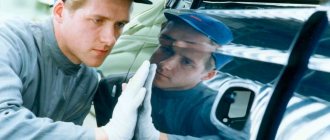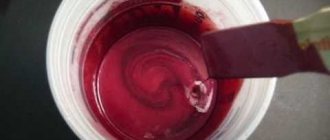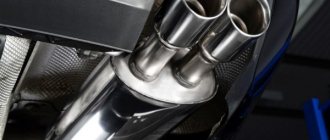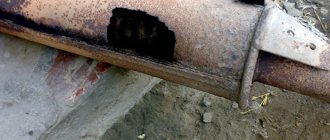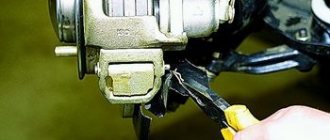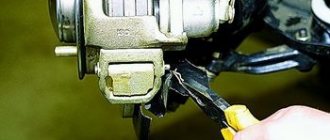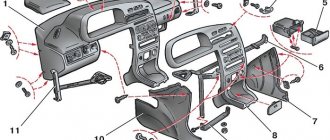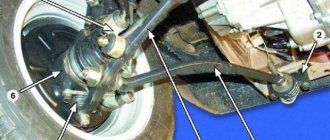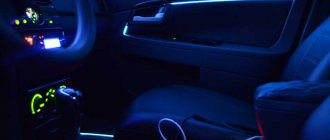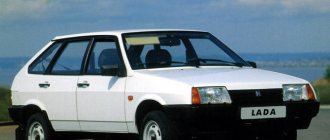Most of the used cars are real rubbish, the problem is in the bodies and their characteristics. Damaged and restored cars are often found - it is not safe to buy these. But how can a beginner recognize a damaged car? You can recognize it, you just need to know what thickness of paint should be on cars.
The fact is that it is very difficult to paint a restored car with a factory paint layer thickness - it is expensive, and not every reseller will paint it perfectly. It is much easier and cheaper to paint it somehow, but beautifully, and hiding all the imperfections. And under the layer of paint there may be a weld that is not factory (often a car is assembled from two or more parts). Under the layer of putty and paint there may be holes and rotten metal.
Knowing how thick the paint on cars usually is, you can recognize a painted car, which means that it was definitely involved in an accident.
How to determine the thickness of paint on a car?
A simple device - a thickness gauge - will help you check your car for paint thickness. This is relatively new equipment that will help you avoid making a mistake when buying a car. It is not at all uncommon for such cases when a beginner chooses a beautifully painted car, and then it turns out that it was restored after a terrible accident literally from scrap metal, the geometry of the body is broken, and there are also other flaws.
A thickness gauge can be purchased at any auto store - the prices for these devices are quite affordable. Let's see how to use this device:
- First of all, the thickness gauge is turned on and applied to the surface being examined - the device will make a certain sound and numbers will appear on the digital screen. This is the thickness of the coating in microns.
- When the paint thickness has been measured, you should compare the result with the factory values. The factory thickness is indicated in special tables - the thickness table is on the Internet, it can be easily found. On average, the paint layer on a car is from 70 to 150 microns - this result is acceptable.
On the working surface of the thickness gauge there is a special sensor that generates waves, and they, in turn, are reflected from the surface of the body. This is how the device picks up signals and converts them into numbers.
When comparing the measurement result with the table, it is worth remembering that the numbers may fluctuate within 10 microns in any area of the body - this is normal. Even at the factory the paint job is not perfect. Paint can have different densities. Anything more is a sign of renovation. On restored surfaces, the paintwork can reach 200 microns or more.
It is also worth remembering that the thickness gauge measures the thickness of the coating with putty and primer. If high values are obtained, repaired areas on the body can be identified.
On video: how to use a thickness gauge.
Paintwork thickness table
You need to know the thickness of the factory coating and compare it with the value obtained when measured with a thickness gauge. Depending on the thickness of the Toyota Harrier paintwork there will be a difference, and whether it is more or less than the factory one, we can conclude whether the car has been repainted. At the end of the article there is a table of factory paint layer thickness values for some brands of cars from different manufacturers.
Analysis of the thickness of the paint layer applied at factories may vary slightly depending on the year of the paintwork thickness of a Toyota Harrier car of the same brand. In addition, the thickness may also be different on different body parts. In one case or another, on average, the size of the paint layer on most modern cars should not exceed the limits of: Do-it-yourself chrome plating of disks Checking the thickness of the paint on the hood of the car The thickness gauge used for measurements shows the value of the paint layer size.
This is the value from its top point of the layer to the surface of the metal of the body part on which the measurement is made. It follows that the device will take into account the thickness of the putty, if it is there. These readings will always be higher than the factory readings.
This result indicates that the car was previously damaged, underwent repairs and subsequent painting. There are cases when measurements on car bodies reveal the thickness of the paint layer to be less than the factory value. This means that there was probably minor local damage at the thickness of the Toyota Harrier paintwork.
It was removed without applying a layer of putty by polishing. Accordingly, the thickness of the coating decreased.
What should be the thickness of paintwork on cars - table and explanations
Classification of thickness gauges In specialized stores they offer the thickness of Toyota Harrier paintwork types of such devices. It goes without saying that the principle of their operation, cost and capabilities are different. Therefore, it makes sense to consider each type separately: Ultrasonic - work with both metal materials and plastic, composites and ceramics.
This makes it possible to measure the thickness of paintwork on the bodies of any car brands, not only on metal surfaces, but also on decorative elements. The main disadvantage is the high price; the cost of an entry-level product starts from 10 rubles.
Eddy current - the sensor evaluates the condition of the coating on any metal with high accuracy. However, the result depends on the conductivity of the part.
Thus, when studying copper and aluminum, the assessment will be as accurate as possible, but on iron, errors already appear. The cost of an eddy current thickness gauge is around 5 rubles.
Electromagnetic - reliable and practical devices that give fairly accurate results. Their price does not exceed 3 rubles, but there are also disadvantages: Magnetic - the functionality is based on the principle of a magnet; the more it is attracted to the body, the more the needle deviates.
Is the paint thickness of 200 microns on the 2014 handicap normal?
Accordingly, a smaller angle of inclination indicates a thick layer of coating, which is alarming. Despite the low price in rubles and ease of operation, the unit is capable of accurately assessing the surface only with a thickness not exceeding 1.5 mm.
How to use a thickness gauge correctly? When purchasing a car on the secondary market, it is not enough to know how the purchase and sale transaction and vehicle registration take place.
Which parts should you check first?
Experts recommend starting from the roof surface - this element is least susceptible to various damages. The roof is tinted very rarely and it is the standard and guideline for all other measurements. The average for the roof will always be lower than for all other parts.
Next, measure the racks - their upper parts can be used as a guide. The front and rear of the body are areas that are very often repaired. You should also pay attention to the front doors and sills. Then measurements are taken in all other external segments.
Don't forget about the internal cavities - the space under the hood, trunk, interior, gas tank hatch.
First of all, measure the parts separately. Suspicious areas are measured 4-5 times - in the center and along the edges. The differences should not be more than 35 microns. Then the arithmetic average is calculated and the total thickness of the paint layer for the entire car is determined.
What types of thickness gauges are there and how to choose
- Electromagnetic thickness gauges. They are distinguished by high measurement accuracy. Capable of measuring the thickness of coatings on iron-containing parts. Thus, if you will be using the device to measure the thickness of coatings applied to plastics or non-ferrous metals, give preference to a different type of thickness gauge.
- Magnetic. Cheap devices. The operation is based on a principle based on the operation of a magnet and a number of sensors. When you bring the device to the paintwork, the magnet is attracted to the car body. Sensors record the force of attraction and, based on the obtained indicator, determine the thickness of the coating. The disadvantage of magnetic thickness gauges is measurement errors.
- Eddy current. They differ favorably from electromagnetic thickness gauges in that they are capable of working with a large number of materials. Eddy current devices have a nuance - they most accurately measure the thickness of coatings on parts with high current conductivity. In other words, an eddy current thickness gauge will accurately determine the thickness of the paintwork on a copper or aluminum body part. When measuring a layer of paint/putty on an iron part, the results will be worse.
- Ultrasonic. Professional thickness gauges that can “work” with any materials. Determine the thickness of paintwork on body parts, bumpers, decorative plastic inserts and other elements of the car.
Paint thickness table
The table below shows the thickness indicators on different cars. It must be remembered that these are approximate figures obtained empirically. Manufacturers themselves cannot accurately answer how thick the paint is on a car that has just left the factory.
Japanese and Korean cars, for example, Toyota and Kia Rio, are painted so that the thickness is in the range of 100-110 microns. The internal elements are painted more thinly - the thickness gauge will show no more than 40 microns. If the body was polished or subjected to any other nano-treatments, this will not increase the readings too much. But protective films can increase the numbers by 100 or 200 microns.
German cars have a coating thickness from 100 to 165 microns. This also applies to the BMW concern. “X5” models have paintwork thicknesses from 120 to 165 microns. At Daewoo they paint bodies up to 90-120 microns. Lada Granta will have a layer thickness from 110 to 140 microns. Priora or Kalina are usually colored within 60-100 microns. Kia Rio is painted from 120 to 150 microns. Chevrolet Cruze - 80-135 microns.
What values indicate additional layers?
If additional layers were applied to the factory paint, then the device will show from 180 to 260 microns or more. This figure is obtained by adding the value of the paint thickness from the factory and the additional layer - all modern devices can handle this.
If the display shows a value of 300 microns or more, then a layer of putty was also applied to the part. A large number is a signal that repairs were carried out and the body was painted over very carefully.
It is also worth remembering that the coating on internal surfaces is thinner. On the Lada Granta it will be from 40 microns and above. Koreans also save on paint - about the same amount on the Kia Rio.
The most important task in the measurement process is to see the first layer of paintwork outside the factory. At the same time, its thickness may completely coincide with the factory values. So, using the device, they check each element in several places and do not forget about the corners and edges. On factory parts there should not be significant differences in thickness within one element.
What does it mean about outside interference?
So. For example, Lada Granta is for sale. Knowing its approximate factory values, you can begin to take measurements and see how much larger they are than the factory values. Repainting is indicated by differences in local numbers from the average throughout the body by 40% or more, as well as an excess of the average values for the car by 190 microns.
Also, the fact of intervention is indicated by indicators higher than in the tables, by 50-90 microns. If minor defects were repaired, the indicators will exceed the norm by 50-150. Exceeding the norms by 150-250 microns will indicate the repair of significant defects. The thickness of the putty will be 250-300 microns higher than normal.
When choosing a car, you must use instruments - everyone uses them. The check will protect you from buying a damaged or damaged car - and it doesn’t matter whether it’s a Lada Granta or a Bentley Bentayga.
Measuring paint thickness on Suzuki and Skoda Rapid (2 videos)
What can help in determining (20 photos)
Paintwork thickness on cars
After purchasing a thickness gauge, the question immediately arises: what should be the thickness of the paint on a “not damaged” car? For 99% of cars, the factory paintwork thickness is in the range of 80-170 microns.
Below is a table of factory paint thicknesses for cars:
| Brand | Model | Paint thickness, microns |
| Paint thickness on Audi | A1, A3, A4, A5, A7, A8 | 100-140 |
| Q3, Q5, Q7 | 110-165 | |
| BMW paint thickness | 1-series, 2-series, 3-series, 5-series, 7-series | 100-165 |
| X1, X3 | 90-110 | |
| X5, X6 | 120-165 | |
| BYD paint thickness | F3 | 75-100 |
| Paint thickness on Cadillac | Escalade,CTS | 120-150 |
| Paint thickness on Chery | Amulet, Tiggo | 100-120 |
| Chevrolet paint thickness | Lanos, Aveo, Cruze, Captiva, Lacetti, Niva | 80-135 |
| Paint thickness on Citroen | C5, C-Elysse | 110-140 |
| C4, C3, Picasso, Berlingo | 75-125 | |
| DS4 | 205-230 | |
| Paint thickness on Daewoo | Nexia, Matiz | 90-120 |
| Paint thickness on Fiat | Albea, Punto | 100-140 |
| Ford paint thickness | Focus | 150-170 |
| Explorer, Kuga | 135-150 | |
| Mondeo | 115-130 | |
| Paint thickness on Hyundai | Accent, IX35, I30, I40, SantaFe, Elantra | 70-110 |
| Tucson, Solaris, Sonata | 90-130 | |
| Paint thickness on Honda | Accord | 135-155 |
| Civic | 105-135 | |
| Fit, CR-V | 80-100 | |
| Paint thickness on KIA | Sportage, Sorento, Cerato, Cee'd, Picanto | 100-145 |
| Soul, Rio, Venga, Optima | 120-150 | |
| Quoris | 150-180 | |
| Lexus paint thickness | RX, ES, LX | 140-160 |
| CT, GX, LS | 120-150 | |
| Mazda paint thickness | 3, 6 | 85-110 |
| CX-7, CX-5 | 90-120 | |
| Paint thickness on Mercedes-Benz (Mercedes) | C, E | 150-170 |
| G.L., M.L. | 100-140 | |
| S | 160-190 | |
| Paint thickness on Mitsubishi | L200, Outlander XL, ASX | 70-95 |
| Lancer, Pajero | 100-125 | |
| Paint thickness on Nissan Nissan | X-trail, Patrol, Juke, Qashqai, Murano, Tiida, Pathfinder | 80-120 |
| Almera, Teana | 120-140 | |
| Paint thickness on Opel | Astra, Corsa, Mocca, Zafira, Insignia, Vectra | 110-160 |
| Paint thickness on Peugeot | 208, 308, 508, 3008 | 100-120 |
| Paint thickness on Renault | Logan, Koleos | 70-130 |
| Fluence, Duster, Megane, Sandero | 100-140 | |
| Paint thickness on Skoda | Octavia, Yeti, Superb, Fabia, Roomster | 100-145 |
| Paint thickness on Suzuki | Grand Vitara, SX4, Swift, Splash | 85-115 |
| Paint thickness on Toyota (Toyota) | LC200, Camry, Highlander, Auris, Verso | 95-130 |
| Avensis, Corolla, Prado, Prius, RAV4 | 80-110 | |
| Paint thickness on Volkswagen | Polo, Golf | 80-110 |
| Tiguan, Passat, Caddy, Multivan, Amarok | 105-140 | |
| Touareg, Jetta | 140-180 | |
| Paint thickness on Volvo | S40, S60, XC90 | 100-150 |
| Paint thickness on Lada, VAZ | Kalina, Priora | 60-100 |
| Granta, Niva | 110-140 |
Tips when measuring car paint thickness:
1. Deviations from the values indicated in the table are always possible. If, for example, on a Skoda Octavia the thickness gauge shows the number 150 (and in the table 100-140), this does not mean that the part was made. There are a lot of factors on which the thickness of the paint of a particular car can depend: for example, the place of assembly, the year of manufacture, how often the car was washed, whether the owner was very diligent in removing snow with a brush in winter, etc.
2. If, when measuring the car on all elements, the paint thickness is 200-250 microns, then you should not immediately think that the car has been repainted. As a rule, this thickness can be found on Mercedes, on Europeans of the premium segment. You also need to listen to the owner, if he claims that nothing has been painted, then it is advisable to try on 1-2 of the same cars, of the same build and the same year of manufacture.
3. It is always better to start measuring from the roof. In this case, it is most likely that the first measurements on the car will be on a factory part.
4. Almost all cars have variations in paint thickness on different parts. If the hood shows 140, and the wing 130, the door on top 120, and below 125, this is a completely normal range of values.
5. As practice shows, VAZ, “Japanese” and “Koreans” apply a thinner layer of paint (about 100 microns).
6. Always on internal elements (sills, inner part of the pillar, inner part of the wing) the layer of paint will be thinner and will be 40-80 microns. This is due to the fact that there is no external influence on these elements (salt, stones from under wheels, etc.).
7. If the machine is dirty, the thickness gauge readings will be inaccurate; minor dirt or dust does not particularly affect the readings.
8. Polishing or nano-coatings do not significantly change the thickness of the paint.
We hope that our advice will help you when choosing a car.
Best regards scaner-avto.ru.
What thickness of paint should be on a car? Table with values and verification technology.
Anyone who has dealt with buying a used car knows that when inspecting a vehicle, they often first of all look at the paintwork, which can tell a lot about the car itself, and then a decision is made to look at its technical part or not. In addition to the visual inspection, the buyer is interested in how thick the paint is on the car and, if there are problem areas, how much they exceed the values of the original paint from the factory. Why is this so important? Such information will help you find out whether the car was in an accident, or whether there were problems with body corrosion, whether putty was used, and what important elements of the body structure might have broken geometry. All these parameters affect the performance of the machine in the future and, of course, the price that the seller asks for it. For example, if you see that the paint thickness on the car pillars has increased significantly, then there may have been a serious accident and you will not want to take such a vehicle for your family, because safety comes first.
How does the measurement happen?
Usually, for these purposes, they buy or rent a device for measuring the thickness of paint on a car. They come in various modifications and prices, so you will definitely find what you can use to measure this parameter during inspection.
In practice, the measurement process looks like this: You will need to place the measuring surface of the device as tightly as possible against the car body and press the button. After which a value will appear on the screen that measures the distance from the device to the metal of the body, thus showing the thickness of the paint layer. If there is putty on the part, it will also be included in the general layer.
In practice, repainted or restored paintwork shows the following parameters:
- Increasing the layer thickness by 2 or more times. For example, if there is putty, values of 800 – 900 microns may appear.
- You can determine exactly the point where the main damage occurred by assessing the differences in the obtained indicators. The thickness of a car's factory paint usually ranges from 10 to 40 microns, and the repainted surface shows values significantly exceeding these values.
Analysis of paint thickness
You know that repairing the paint layer of a car can be of two options: complete and partial. It is the local repainted areas that often come up when checking a car, and hence either bargaining or refusal of further inspection. As a basis, you always take the factory indicator that is applied to new cars, and see how much it exceeds or falls below the value you received on the device screen.
If we talk about the factory technology for applying paintwork, it is also not ideal and the thickness of the paintwork layer can vary depending on the brand and year of manufacture of the same manufacturer model.
Among craftsmen, it is believed that the thickness of factory paint should be in the range of 75 - 165 microns.
And if everything is crystal clear with additional layers of material, then what to do if the device shows a value less than the minimum mark? This also happens because it is a consequence of polishing the body or its individual elements. During this procedure, abrasive pastes remove part of the coating layer and the thickness becomes smaller.
Algorithm for measuring paint thickness on a car
Having previously found out the factory values in the manufacturer's technical description, you can go out to inspect the car. The analysis technology itself proceeds as follows.
- We measure the roof, this is to check that the car is not a “shifter”.
- The next parts to look at are the racks. They often suffer in a frontal impact.
- Next, we analyze the bumpers, sills and doors of the car. You can randomly check the part in different places, this will help determine local painting.
- Additionally, you need to measure the layer on internal parts, such as the hood. In such places, the thickness of the paintwork should be in the range of 50-90 microns.
Do not forget that the indicators along the entire plane of the body will differ slightly by 10 - 40 microns, this is due to the painting technology at the factory and this is normal.
Here is a table that will help you figure out what the coating thickness of parts should be for car models from different manufacturers. All values are in microns.
That's all. These are the basic concepts that you must have in order to correctly measure the paint layer on a car and determine whether there has been any damage to the body as a whole. This approach can save you not only money, but also nerves on future vehicle maintenance. Do you use such devices when buying a car?
Paint thickness by make and model for NOT damaged cars: table
When buying a used car, the first thing we look at is its appearance; it is no coincidence that they say that you meet someone by their clothes. If nothing is warped, has not fallen off and looks beautiful, that’s good. But not enough. Now we need to check the condition of the body, and with passion, otherwise we may end up with a damaged car, and if we ignore this process, it will be very well damaged.
You are unlikely to be able to find out what the thickness of the paint is by eye. Even an experienced bodyworker will be able to visually determine whether the car has been painted by drips or different shades of paint at the joints. The difference in thickness can only be detected using a thickness gauge. It will show with high accuracy a deviation from the norm if the car has been in an accident and its body has been damaged.
Damaged bodies, as a rule, have a thicker layer of paint than undamaged ones, for which it is about 80–250 microns (the spread depends on the model and brand). In garage conditions, such a result is difficult to achieve. And if you consider what layer of putty had to be applied after the accident, it is simply impossible.
Of course, they will try to convince you that the car is not damaged, but here is a table to help you, which shows the thickness of the paintwork on cars of various brands and models. If the thickness gauge readings do not match the specified parameters, then you have a problem specimen. For example, for Toyota Prius, Rav4, the thickness of the paintwork is 80 - 90 microns, for Mazda CX-7, CX-5 - 85 - 120 microns, Ford Focus - 156 - 160 microns... As you can see, this table is interesting in itself, but Buying a car is simply irreplaceable if you take this process seriously.
| Brand | Model | Paint thickness (µm) | Brand | Model | Paint thickness (µm) |
| LC200, Camry | 110-130 | Albea | 115-130 | ||
| Avensis, Highlinder | 80-120 | Punto | 111 | ||
| Auris,Verso | 110 | MK | 80-100 | ||
| Corolla | 106 | Otaka | 75-80 | ||
| Prius, RAV4 | 80-90 | Accent, IX 35 | 70-75 | ||
| C5 | 110-130 | I30, I40 | 100-110 | ||
| C4 | 75-125 | Santa Fe, Elantra | 70-100 | ||
| C3 | 90-120 | Solaris, Sonata | 85-100 | ||
| X-Trail, Patrol | 75-120 | Tucson | 90-130 | ||
| Juke, Qashkai | 110-125 | Logan, Koleos | 55-120 | ||
| Murano | 95 | Fluence, Morgan | 100-140 | ||
| Tiida, Navara | 105-115 | Duster, Sandero | 105-115 | ||
| Pathfander | 100-110 | Kalina, Priora | 60-100 | ||
| Almera, Teana | 130-150 | Granta | 98 | ||
| CX-7, CX-5 | 85-120 | Lancer, Pajero | 90-125 | ||
| 3,6 | 110-130 | L200, Outlandre XL | 53-75 | ||
| S60 | 110-130 | ASX | 70 | ||
| S60 II | 95-115 | Accord 7 | 130-145 | ||
| XC70, C30, S80 | 105-140 | Civic 4D | 100-135 | ||
| XC90, XC60 | 115-140 | Fit, CR-V | 87-98 | ||
| A5, A6, A7, A8 | up to 100 | Nexia | 95-115 | ||
| Q3, Q5, Q7 | 114-147 | Matiz | 110 | ||
| FX35 | 116 | Octavia, Roomster | 120-125 | ||
| C, E | 230-250 | Fabia, Yeti, Superb | 99-120 | ||
| G.L., M.L. | 90-100 | Forester, Legacy | 110-115 | ||
| X1 | 110 | Imprezza, Outback | 125-140 | ||
| X3, M6, 5 | 89-100 | Tribeca | 120 | ||
| X5, X6 | 120-165 | Polo, Golf, Jetta | 80-105 | ||
| 5er(E60) | 130-165 | Touareg, Tiguan | 70-85 | ||
| Kyron | 100-110 | Sportage, Cerato | 110-120 | ||
| F3 | up to 100 | Picanto, Rio, Soul | 100-110 | ||
| Amulet | 110-120 | Venga, Optima | 120-125 | ||
| Tiggo | 105 | Sorento, Cee'd | 100-105 | ||
| Siber | 90-105 | 308, 508, 3008 | 100-115 | ||
| GAZ-3110 | 80 | 4008 | 58-61 | ||
| Lanos, Aveo | 75-150 | Occasioned | 98 | ||
| Captiva, Epica | 90-100 | Grand Vitara | 77-94 | ||
| Niva, Spark | 94-98 | Splash, SX4, Swift | 90-115 | ||
| Lacetti, Cruz | 110-140 | RX, ES, LX | 140-145 | ||
| Explorer, Kuga | 135-145 | CT, GX, LS | 125-150 | ||
| Focus | 156-160 | Astra (turbo, gtc) | 110-157 | ||
| Mondeo | 119-127 | Corsa, Zafira | 115-120 |
However, it must be taken into account that on one car the thickness of the paintwork may be different on doors, fenders and other body elements. There is no way to determine this visually, and it cannot be considered a marriage. The fact is that different body panels can be painted on different lines and using different technologies. However, if the thickness is within tolerance (at the factory it can be 15 - 30 microns), then there is nothing to worry about.
But what if the paint thickness is below normal? No way. A thinner layer indicates that the car has been polished, and this is perhaps even a plus. True, you shouldn’t get carried away with polishing.
So, when buying a car, we should be wary, first of all, of the thickness of the paintwork that exceeds the norm. However, if the damaged area is small and the power elements of the body were not damaged by the impact, then it is quite possible to buy the car, and even at a good discount.
Photo: Internet resources
